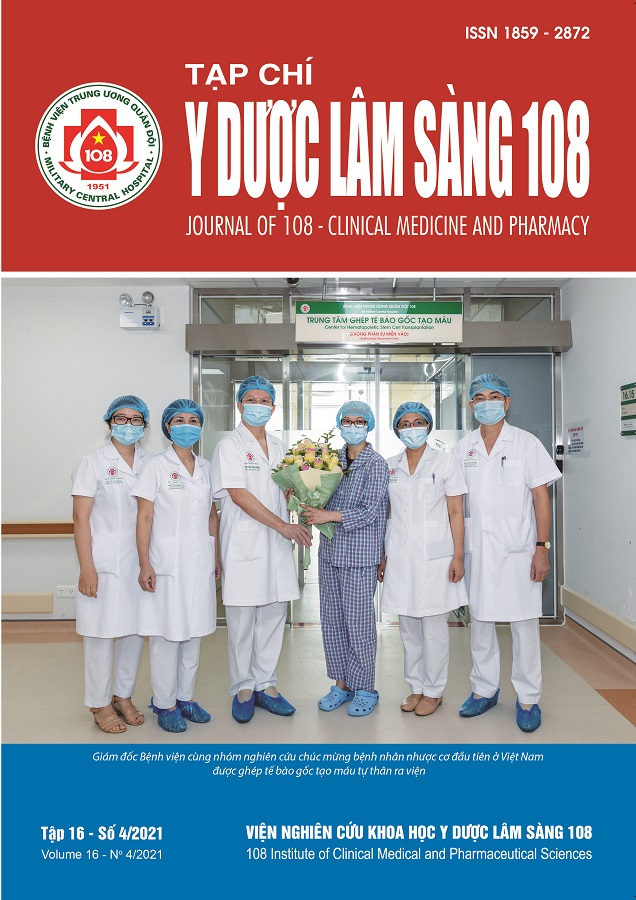Evaluation of serum copper and copper to ceruloplasmin ratio in adult patients with plaque psoriasis at Ho Chi Minh City Hospital of Dermatology and Venereology
Main Article Content
Keywords
Abstract
Objective: To compare serum copper and copper to ceruloplasmin ratio between the patients and the controls. To identify the relationship between serum copper, copper to ceruloplasmin ratio and clinical characteristics. Subject and method: We designed a cross-sectional study with convenience sampling of 66 cases of psoriasis patients and 66 normal people at dermatology clinic of Ho Chi Minh City Hospital of Dermatology and Venereology during the period January 2021 to June 2021. Result: Mean age was 44 years old. 74.2% of the patients were male. 15% of the patients had family history of psoriasis. There was no significant difference in serum copper levels between the cases and the controls (mean 76.7µg/dL vs mean 75.4µg/dL, p=0.55). Serum ceruloplasmin levels were significantly raised among the cases as compared with the controls (mean 41.2mg/dL vs mean 32.7mg/dL, p=0.001). Serum copper to ceruloplasmin ratio were significantly low in the psoriasis group as compared with the controls (mean 2.1 vs mean 2.4, p=0.001). Females have higher levels of both serum copper and copper to ceruloplasmin ratio than males (p=0.017, p=0.039). The older the patients get, the higher levels of serum copper they have (p=0.036, r = 0.26). Patients who drink alcohol more than once a month had lower copper to ceruloplasmin ratio than those who do not drink (p=0.049). Conclusion: There is no difference in serum copper level between the controls and the patients. The patients have lower copper to ceruloplasmin ratio than the controls. Serum copper raise as the patients get older. Gender can affect serum copper level and copper to ceruloplasmin ratio in psoriasis patients. Copper to ceruloplasmin is found to be relative to alcohol consumption
Article Details
References
2. Amtage F et al (2014) Estrogen intake and copper depositions: Implications for alzheimer's disease. Case Reports in Neurology 6(2): 181-187.
3. Cannavò SP et al (2019) Oxidative stress involvement in psoriasis: A systematic review. Free Radic Res 53(8): 829-840.
4. Chen W Zhou X and Zhu W (2019) Trace elements homeostatic imbalance in psoriasis: A meta-analysis. Biol Trace Elem Res 191(2): 313-322.
5. Grochowski C et al (2019) Serum iron, magnesium, copper, and manganese levels in alcoholism: A systematic review. Molecules 24(7).
6. Linder MC (2021) Apoceruloplasmin: Abundance, detection, formation, and metabolism. Biomedicines 9(3).
7. Orzheshkovskyi VV and Trishchynska MA (2019) Ceruloplasmin: Its role in the physiological and pathological processes. Neurophysiology 51(2): 141-149.
8. Phạm Thị Mỹ Hằng và Đặng Văn Em (2017) Nghiên cứu nồng độ kẽm, đồng trong huyết thanh bệnh nhân vảy nến thông thường. Tạp chí Y học Việt Nam, 459(1), tr. 174-176.
9. Shahidi-Dadras M, Namazi N, and Younespour S (2017) Comparative analysis of serum copper, iron, ceruloplasmin, and transferrin levels in mild and severe psoriasis vulgaris in iranian patients. Indian Dermatol Online J 8(4): 250-253.
10. Rashmi R, Yuti, AM, and Basavaraj KH (2010) Relevance of copper and ceruloplasmin in psoriasis. Clinica Chimica Acta 411(17): 1390-1392.
 ISSN: 1859 - 2872
ISSN: 1859 - 2872
